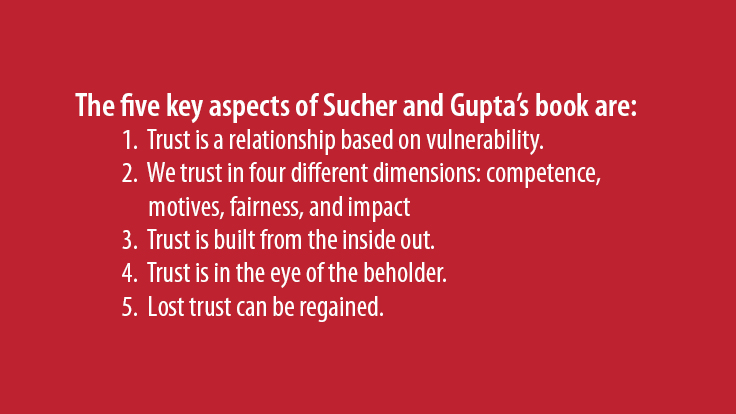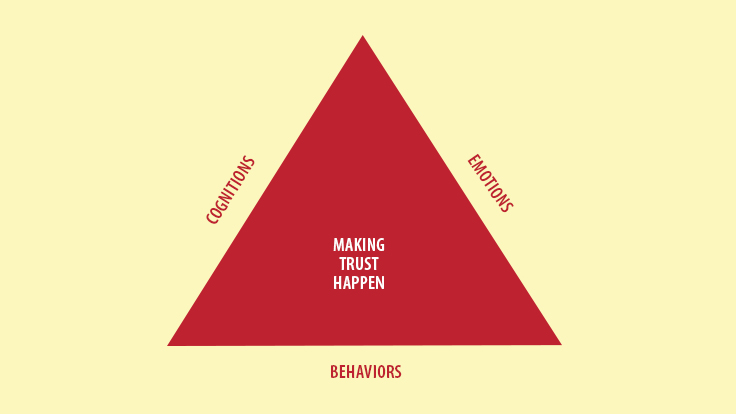In our book, Making Trust Happen! How To Think and Talk About Trust & Experience & Create It we provide a “trust glossary” to enhance “trust conversations.” We suggest that we enrich these conversations when we’re explicit about what we’re saying when we say “trust.”
Complementary Approaches To Trust
Our book focuses on six “trust behaviors:” trusting, trustworthiness, trust relationships, trust structure, self-awareness, and systemic. We emphasize how employees interact with each other and their organization.
In their article, Sandra Sucher and Shalene Gupta, The Power of Trust: How Companies Build It, Lose It, Regain It, focus on “company trust” and the “company-customer interaction.”
PAIGE/PACE | SUCHER/GUPTA |
| Individual/Organization | Customer/Company |
A Relationship Based on Vulnerability
Let’s explore the authors’ first key point: Trust is a relationship based on vulnerability.

Sucher & Gupta provide the following definition from their book by the same name as the article.
To trust fundamentally means to make yourself vulnerable to the actions of others. We trust because we believe they will do the right by us.
They elaborate on this:
When we choose to trust someone, we willingly give them power over us, trusting they will not abuse this power.
For them:
Trust is a special form of dependence, and is predicated on the idea that we can be more than disappointed; we can be betrayed.
Borrowing from Paul Lencioni’s work on The Five Behaviors of a Cohesive Team, we also use the concept “vulnerability.” We and Sucher & Gupta use “vulnerability” similarly.
To be vulnerable is to be “unguarded.”
For us, it’s the ability to be “trusting” of our teammates. For Sucher & Gupta, that means a company must be “trusting.”.
We’ve found that “vulnerability” is challenging because people don’t want to “open up.” After all, they don’t want to be exposed. They don’t want to feel threatened.
Sucher & Gupta highlight the role “power” plays in “trusting” or “non-trusting.” Exposure “opens us up to the possibility of being manipulated” they note.
Why? They say that when we’re trusting, we give someone power over us.
A Relationship Based On Trustworthiness
Here Sucher & Gupta inject another concept, “trustworthiness.”
“We trust because we believe [that someone or a company] will do the right by us,” they write. In other words, we trust because a company is reliable and dependable.
As noted by Sucher & Gupta, underlying this combination of trusting (vulnerability) and trustworthiness (reliability) are two essential emotions — disappointment and betrayal.
For them, “trust” is a “special form of dependence. The authors explain that the predicate for “trust” is that we can be more than disappointed; we can be betrayed.”
Cognitive, Emotional and Behavioral Aspects of Trust
In reading Sucher and Gupta’s “The Power of Trust,” we’re reminded that we must highlight our six dimensions of trust’s cognitive, emotional, and behavioral aspects to experience and create trust fully.

For Sucher & Gupta, the opposite of disappointment and betrayal is “peace of mind.” For us, when we “make trust happen,” we create “ease of being.”
Here’s a comparison of the different approaches to trust have cognitive (conceptual), emotional and behavioral components.
| TRUST AS AN EMOTION | PAIGE/PACE | SUCHER/GUPTA |
Mis-Trust Negative Emotions | Dissonance When Trust Realizations are Less Than Trust Expectations | Disappointment/Betrayal |
Trust Positive Emotions | Ease of Being | Peace of Mind (Never Having to Worry) Never Feeling You’re Going to Be Taken Advantage of) |
The Magic of Trust
In the last chapter of their book, Sucher & Gupta write: “The magic of trust is that it unlocks a wealth of potential opportunities that would not be possible otherwise.” For us, when we make trust happen, relationships are strengthened, second-guessing is eliminated, and life is easier.
Send us the concept of “trust” you use when you’re holding your trust conversations.
